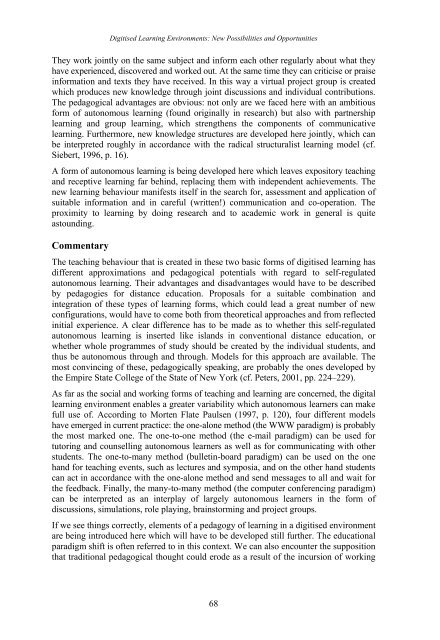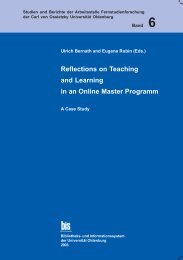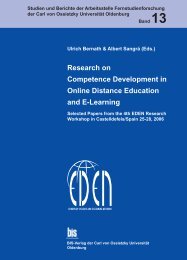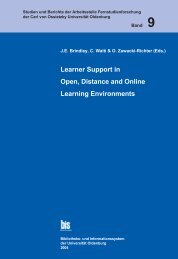Distance Education in Transition - Master of Distance Education ...
Distance Education in Transition - Master of Distance Education ...
Distance Education in Transition - Master of Distance Education ...
You also want an ePaper? Increase the reach of your titles
YUMPU automatically turns print PDFs into web optimized ePapers that Google loves.
Digitised Learn<strong>in</strong>g Environments: New Possibilities and Opportunities<br />
They work jo<strong>in</strong>tly on the same subject and <strong>in</strong>form each other regularly about what they<br />
have experienced, discovered and worked out. At the same time they can criticise or praise<br />
<strong>in</strong>formation and texts they have received. In this way a virtual project group is created<br />
which produces new knowledge through jo<strong>in</strong>t discussions and <strong>in</strong>dividual contributions.<br />
The pedagogical advantages are obvious: not only are we faced here with an ambitious<br />
form <strong>of</strong> autonomous learn<strong>in</strong>g (found orig<strong>in</strong>ally <strong>in</strong> research) but also with partnership<br />
learn<strong>in</strong>g and group learn<strong>in</strong>g, which strengthens the components <strong>of</strong> communicative<br />
learn<strong>in</strong>g. Furthermore, new knowledge structures are developed here jo<strong>in</strong>tly, which can<br />
be <strong>in</strong>terpreted roughly <strong>in</strong> accordance with the radical structuralist learn<strong>in</strong>g model (cf.<br />
Siebert, 1996, p. 16).<br />
A form <strong>of</strong> autonomous learn<strong>in</strong>g is be<strong>in</strong>g developed here which leaves expository teach<strong>in</strong>g<br />
and receptive learn<strong>in</strong>g far beh<strong>in</strong>d, replac<strong>in</strong>g them with <strong>in</strong>dependent achievements. The<br />
new learn<strong>in</strong>g behaviour manifests itself <strong>in</strong> the search for, assessment and application <strong>of</strong><br />
suitable <strong>in</strong>formation and <strong>in</strong> careful (written!) communication and co-operation. The<br />
proximity to learn<strong>in</strong>g by do<strong>in</strong>g research and to academic work <strong>in</strong> general is quite<br />
astound<strong>in</strong>g.<br />
Commentary<br />
The teach<strong>in</strong>g behaviour that is created <strong>in</strong> these two basic forms <strong>of</strong> digitised learn<strong>in</strong>g has<br />
different approximations and pedagogical potentials with regard to self-regulated<br />
autonomous learn<strong>in</strong>g. Their advantages and disadvantages would have to be described<br />
by pedagogies for distance education. Proposals for a suitable comb<strong>in</strong>ation and<br />
<strong>in</strong>tegration <strong>of</strong> these types <strong>of</strong> learn<strong>in</strong>g forms, which could lead a great number <strong>of</strong> new<br />
configurations, would have to come both from theoretical approaches and from reflected<br />
<strong>in</strong>itial experience. A clear difference has to be made as to whether this self-regulated<br />
autonomous learn<strong>in</strong>g is <strong>in</strong>serted like islands <strong>in</strong> conventional distance education, or<br />
whether whole programmes <strong>of</strong> study should be created by the <strong>in</strong>dividual students, and<br />
thus be autonomous through and through. Models for this approach are available. The<br />
most conv<strong>in</strong>c<strong>in</strong>g <strong>of</strong> these, pedagogically speak<strong>in</strong>g, are probably the ones developed by<br />
the Empire State College <strong>of</strong> the State <strong>of</strong> New York (cf. Peters, 2001, pp. 224–229).<br />
As far as the social and work<strong>in</strong>g forms <strong>of</strong> teach<strong>in</strong>g and learn<strong>in</strong>g are concerned, the digital<br />
learn<strong>in</strong>g environment enables a greater variability which autonomous learners can make<br />
full use <strong>of</strong>. Accord<strong>in</strong>g to Morten Flate Paulsen (1997, p. 120), four different models<br />
have emerged <strong>in</strong> current practice: the one-alone method (the WWW paradigm) is probably<br />
the most marked one. The one-to-one method (the e-mail paradigm) can be used for<br />
tutor<strong>in</strong>g and counsell<strong>in</strong>g autonomous learners as well as for communicat<strong>in</strong>g with other<br />
students. The one-to-many method (bullet<strong>in</strong>-board paradigm) can be used on the one<br />
hand for teach<strong>in</strong>g events, such as lectures and symposia, and on the other hand students<br />
can act <strong>in</strong> accordance with the one-alone method and send messages to all and wait for<br />
the feedback. F<strong>in</strong>ally, the many-to-many method (the computer conferenc<strong>in</strong>g paradigm)<br />
can be <strong>in</strong>terpreted as an <strong>in</strong>terplay <strong>of</strong> largely autonomous learners <strong>in</strong> the form <strong>of</strong><br />
discussions, simulations, role play<strong>in</strong>g, bra<strong>in</strong>storm<strong>in</strong>g and project groups.<br />
If we see th<strong>in</strong>gs correctly, elements <strong>of</strong> a pedagogy <strong>of</strong> learn<strong>in</strong>g <strong>in</strong> a digitised environment<br />
are be<strong>in</strong>g <strong>in</strong>troduced here which will have to be developed still further. The educational<br />
paradigm shift is <strong>of</strong>ten referred to <strong>in</strong> this context. We can also encounter the supposition<br />
that traditional pedagogical thought could erode as a result <strong>of</strong> the <strong>in</strong>cursion <strong>of</strong> work<strong>in</strong>g<br />
68





